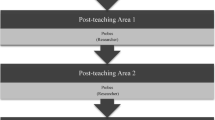Abstract
The purpose of the study was to facilitate the adjustment of adults who are severely disabled by autism to the job setting. Three cases are presented that illustrate the use of on-the-job training procedures to manage behavior problems of adults with autism. In two cases aggressive and oppositional behavior were eliminated or reduced in frequency, and in a third case production rate was increased. The feasibility of on-the-job training of adults with autism is discussed, and expanded research into vocational training programs is recommended.
Similar content being viewed by others
References
American Psychiatric Association. (1980).Diagnostic and statistical manual of mental disorders (3rd ed.). Washington, D.C.: Author.
Horn, J. I. (1982).A program of living skills training for autistic adolescents and adults in a residential treatment setting. (Published on demand by University Microfilms International, 300 Zeeb Road, Ann Arbor, Michigan).
Howlin, P., Marchant, R., Rutter, M., Berger, M., Hersov, L., & Yule, W. (1973). A homebased approach to the treatment of autistic children.Journal of Autism and Childhood Schizophrenia, 3, 308–336.
Kanner, L., Rodriguez, A., & Ashenden, B. (1972). How far can autistic children go in matters of social adaptation?Journal of Autism and Childhood Schizophrenia, 2, 9–33.
Kazdin, A. (1979). Advances in child behavior therapy: Applications and implications.American Psychologist, 34, 981–987.
Levy, S. (1983). School doesn't last forever; what then? In E. Schopler & G. Mesibov (Eds.),Autism in adolescents and adults (pp. 133–148). New York: Plenum Press.
Lovaas, O. I. (1961). Interaction between verbal and nonverbal behavior.Child Development, 32, 329–336.
Lovaas, O. I., Koegel, R., Simmons, J. Q., & Long, J. S. (1973). Some generalization and follow-up measures on autistic children in behavior therapy.Journal of Applied Behavior Analysis, 6, 131–166.
Margolies, P. J. (1977). Behavioral approaches to the treatment of early infantile autism: A review.Psychological Bulletin, 84(2), 249–264.
Mesibov, G. (1983). Current issues on autism and adolescence. In E. Schopler & G. Mesibov,Autism in adolescents and adults (pp. 37–56). New York: Plenum Press.
Mesibov, G., Schopler, E., & Sloan, J. (1983). Service delivery for adolescents and adults in North Carolina's TEACCH Program. In E. Schopler & G. Mesibov (ed.),Autism in adolescents and adults (pp. 411–432). New York: Plenum Press.
National Society for Autistic Children. (1977).Definition of the syndrome of autism. Washington, D.C.: Author.
O'Leary, K., & Wilson, G. T. (1975).Behavior therapy: Application and outcome. Englewood Cliffs, New Jersey: Prentice-Hall.
Reichler, R. J., & Schopler, E. (1976). Developmental therapy: A program model for providing services in the community. In E. Schopler & R. J. Reichler (Eds.),Psychopathology and child development (pp. 347–371). New York: Plenum Press.
Russo, D. C., & Koegel, R. L. (1977). A method for integrating an autistic child into a normal public school classroom.Journal of Applied Behavior Analysis, 10, 579–590.
Rutter, M.,& Schopler, E. (1978).Autism: A reappraisal of concepts and treatment. New York: Plenum Press.
Schopler, E. (1978). Changing parental involvement in behavioral treatment. In M. Rutter & E. Schopler (Eds.),Autism: A reappraisal of concepts and treatment (pp. 413–422). New York: Plenum Press.
Schopler, E., & Mesibov, G. (1983).Autism in adolescents and adults. New York: Plenum Press.
Schopler, E., & Reichler, R. J. (1971). Parents as cotherapists in the treatment of psychotic children.Journal of Autism and Childhood Schizophrenia, 1, 87–102.
Smith, M. D., & Belcher, R. G. (1983, August).Teaching independent living skills to autistic adults. Paper presented at the meeting of the American Psychological Association, Anaheim, California.
Sullivan, R. (1977). National information and advocacy project for autistic and autistic-like persons. HEW grant #54P-71207/1-03.
Webster, C. D. (1980). The characteristics of autism. In C. Webster, M. Konstantareas, J. Oxman, & J. Mack,Autism: New directions in research and education (pp. 5–11). New York: Pergamon Press.
Wolf, M. M., Risely, T. R., & Mees, H. L. (1964). Application of operant conditioning procedures to the behavior problems of an autistic child.Behaviour Research and Therapy, 1, 305–312.
Woods, T. (1982). Reducing severe aggressive and self-injurious behaviors: A nonintrusive home-based approach.Behavioral Disorders, 7, 180–188.
Author information
Authors and Affiliations
Additional information
Preparation of this article was supported in part by the United States Department of Education Grant G008430115, by the National Institute of Handicapped Research, Department of Education Grant G008435019, and by a Mary Switzer Fellowship from the National Institute of Handicapped Research. However, the opinions expressed herein do not necessarily reflect the position or policy of the U.S. Department of Education. The work presented in this article was conducted at Community Services for Autistic Adults and Children, 751 Twinbrook Parkway, Rockville, Maryland. We gratefully acknowledge Patricia Juhrs for her administrative support, Frank Warren for his valuable assistance on the final draft, Judy Lewis for her clerical assistance, Derek Berrian for preparing the figures, and Jack Smith for reviewing and editing the draft of this article.
Rights and permissions
About this article
Cite this article
Smith, M.D., Coleman, D. Managing the behavior of adults with autism in the job setting. J Autism Dev Disord 16, 145–154 (1986). https://doi.org/10.1007/BF01531726
Issue Date:
DOI: https://doi.org/10.1007/BF01531726




